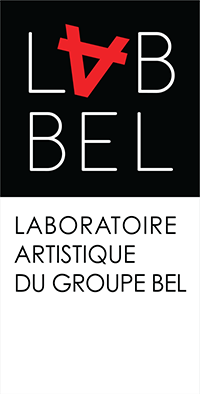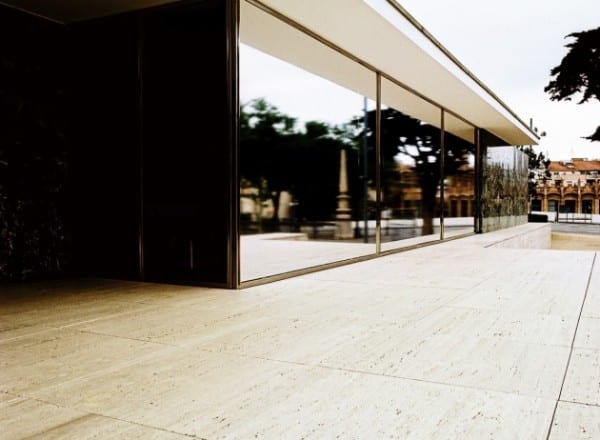“The World trapped in the self ” (Mirrors for windows)
In collaboration with the Mies van der Rohe Foundation, Barcelona and the Galerie Yvon Lambert, Paris.
The German Pavilion by Mies van der Rohe is an architectural creation that is emblematic of the beginning of the twentieth century. Built for the World’s Fair in 1929 in Barcelona, its austerity and formal simplicity makes it stand out. This building’s innovative open floor plan that dissolves spatial separations and its straightforward communication between the interior and the exterior have inspired a new history of architecture. Dismantled at the end of the World’s Fair and then identically rebuilt at the same location (1983-1986), it is now one of the city’s tourist attractions.
On several different occasions, visual artists have shown in the pavilion, such as Antoni Muntadas, Jeff Wall, Dennis Adams and Ai Weiwei, who recently filled the Pavilion’s fountains with milk and coffee.
SUNGLASSES
The World is a prisoner of its own making as if it has been abruptly locked behind a partition of mirrors.
The young Mexican artist Stefan Brüggemann – facing up to the intimidating challenge of showing in Barcelona’s famous Mies van der Rohe Pavilion (a challenge laid down by Lab’Bel) – follows the maxims Less is more and Gott steckt im Detail (God is in the detail). In order to extol the virtues of the architecture, he has chosen an approach as minimalist as it is radical: replacing the three windows of the principle facade with reflective surfaces.
With this choice, the artist revisits the relationship between darkness and transparency in architecture by simultaneously shattering the structure of the façade and rendering it more concrete. The artist accomplishes this separation by blocking light inside the building and rejecting the outdoor light. He enacts a new spatial experiment that turns upside down the free circulation and the aesthetic and philosophical principles at the heart of this architecture.
By inviting him to explore the recesses of his mind and question what informs his vision of the world (and therefore recreating his gaze and allowing us to better enter his artistic universe), Stefan Brüggemann includes everything, including the visitor, in his view of his world. This takes physical shape with the projection of his image on the pavilion’s facade through the simple use of reflection, which he in turn violently rejects by blocking his own gaze. We can see this as a way to distinguish the uniqueness of his approach and to use humor to underline his ability to turn something inside out.
Just as the visitor finds himself confronted with the projected personification of Morning (as imagined by Georg Kolbe) who suddenly stretches out in front of the fountain’s liquid surface, he is also confronted by himself, face to face with his critical analysis of this artistic creation, whether it be iconoclast or respectful: this location helps the visitor come to terms with his own train of thought and to articulate his concerns.
Deeply ambivalent, Stefan Brüggemann’s approach to this intervention brings us back to the image of the mirror which the artist, at times, so enjoys hanging the backwards: the perception generated by his intervention swallows everything up and risks being stifling, much like a posited claim that is still susceptible to doubt and wonder. It resembles a mirror reflecting light, which can both blind and dazzle the eyes.
Laurent Fiévet, co-curator.
THE WORLD TRAPPED IN THE SELF (MIRRORS FOR WINDOWS)
When the World looks in the mirror does it see perfection?
It may not be blind to its perfection, but perfection is boring.
The World’s perfection is its final delusion: man has designed another world richer and more complete than this world and this new one, like the first, is already burning up under the sun.
The Sun’s reflection in the mirror causes it to go up in flames.
Through Stefan Brüggemann’s simple material alterations to Barcelona’s Mies van der Rohe Pavilion, our gaze is held, captivated, by its own image – like a metaphor for this contemporary world.
Duality is a theme in the Pavilion: the marble veining and travertine grain repeat. Stefan Brüggemann’s intervention transforms the transparencies into mirrors through a slight of the hand that allows the spectator to see multiples of himself.
Since its renovation in 1986, art and architecture come together in this timeless work by Mies van der Rohe. Stefan Brüggemann’s ephemeral invention terminates this dream of eternal life.
The sociologist Bruno Latour deemed that we were never modern, but Brüggemann pushes us to be hypermodern. We must march to the rhythm of our time.
Silvia Guerra, co-curator.
STEFAN BRÜGGEMANN
Stefan Brüggemann (born in Mexico City in 1975) lives and works in London and Mexico City. His work associates a conceptual practice with a raw attitude and criticism that simultaneously calls into question his own approach while it reflects on the present societal context. Even if the artist works principally with text, using the materials of vinyl and neon lights, he explores a wide array of mediums, ranging from video, to painting and drawing. The works of Stefan Brüggemann draw their meaning from a strange combination of philosophical concepts and popular imagery, often inspired by punk ideals and attitudes (nonconformism, provocation, and cynicism), which emerge from tautological expressions. They rely on a certain self-contained logic, but also point to the context in which they were conceived and the goal of eventually inserting a pop sensibility into certain conceptual practices.
Stefan Brüggemann recently exhibited at the Kunsthalle in Bern, the Museum of Contemporary Art in Chicago, the Yvon Lambert Gallery in Paris, the Blow de La Barra in London, the Bass Museum in Miami, the Schirn Kunsthalle in Frankfort and the Museum of Contemporary Art in Cincinnati.
His intervention at the Mies van der Rohe Pavilion was produced by Lab’Bel in collaboration with Swab and the Mies van der Rohe Foundation, with the kind help of Séverine Waelchli at the Yvon Lambert Gallery (Paris).
Credits & Acknowledgements
Producer: Lab’Bel
in collaboration with Swab and the Mies van der Rohe Foundation.
Curators: Laurent Fiévet and Silvia Guerra.
Exhibition Designer: petit CABANON (Inês Moreira + Paulo Mendes).
Technician: Produções Reais.
Medias relations: Fouchard Filippi Communications.
Graphic Designer: Akatre.
English translation: Ellen LeBlond-Schrader.
Lab’Bel would like to thank all the artists and the galleries that
participated and contributed to the project Art for Life / Art for Living,
Stefan Brüggemann and Séverine Waelchli (at the Yvon Lambert Gallery),
Joaquin Diez-Cascon, Monica Alvarez Careaga and the entire team at Swab,
Lluis Hortet and the entire team at the Mies van der Rohe Foundation,
and also Alessio Antoniolli (at Gasworks), Tere Badia (at Hangar) and
Christian Merlhiot (at the Pavillon du Palais de Tokyo), Gilles Baume, Laure Confavreux-Colliex and Audrey Illouz (at Lab’Bel), Gilles Gaujal and Evelyne Rosier (at Unibel) and Sandrine Watteblé (at Bel Group).

